If you thought that the Riviera Romagnola was a promising destination only for summer holidays, where you can relax under the sunlight of one of the most famous Italian beaches and have fun after the hectic rhythm of the nightlife, then they have only told you part of the wholestory! And, believe us, they didn't tell you the most beautiful and exciting one...do you want to know it with us? Brace yourself! Today we travel to discover the unexpected side of Romagna you probably don’t know, destination San Leo: a real historical and panoramic jewel standing out in the panorama of the hinterland of Rimini.
Discover with us the wonderful beauties of this frontier land and enjoy this exciting journey through the history and stories that characterize San Leo and its territory. Are you planning a holiday in Romagna? Then we recommend you to read this article until the end: you will find a lot of useful suggestions to best enjoy your travel experience to Rimini and discover the most beautiful places and attractions of this fantastic seaside appreciated by tourists from all over the world!

Where is San Leo in the province of Rimini: discovering Valmarecchia
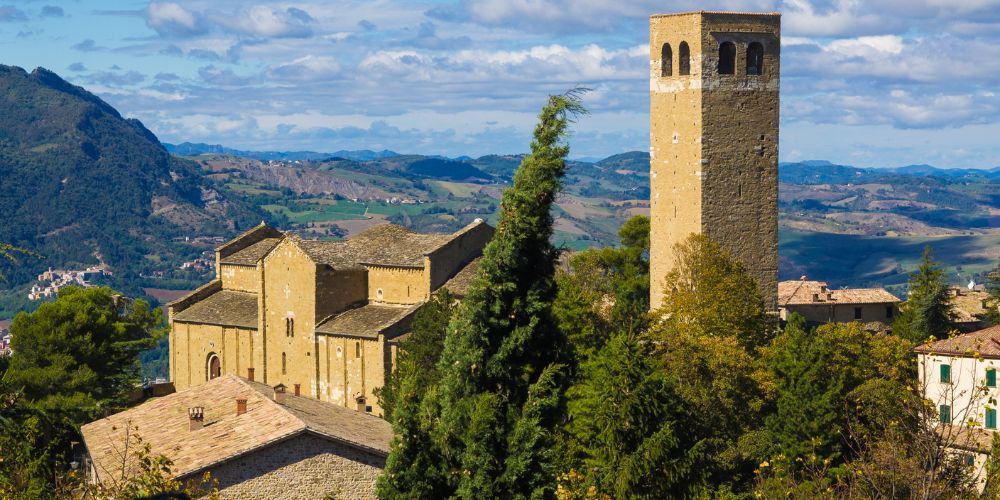
Within the province of Rimini, San Leo is located in the center of the territory South-West of the capital and on the border with the state of San Marino, as well as not too far from the borders with Marche and Tuscany regions. The suggestive scenery of San Leo, in the historical region known as Montefeltro, is characterized by the splendid Valmarecchia and its natural landscape, defined by the flow of the namesake river (up to its mouth in Rimini) and its tributaries and dominated by hills and Apennines.
And it’s exactly on top of a rocky spur of these mounts that the astonishing sight of this unmissable village in Romagna strikes the eye, with its majestic fortress silently perched on the highest point, like a sleeping mythological creature, and a little further down its fascinating village, where you can still breathe the purity of history among ancient stone-paved streets and monumental buildings. So what are we waiting for? Let's start right away discovering San Leo and its attractions!
What to see in San Leo: let's roaming the history of Montefeltro
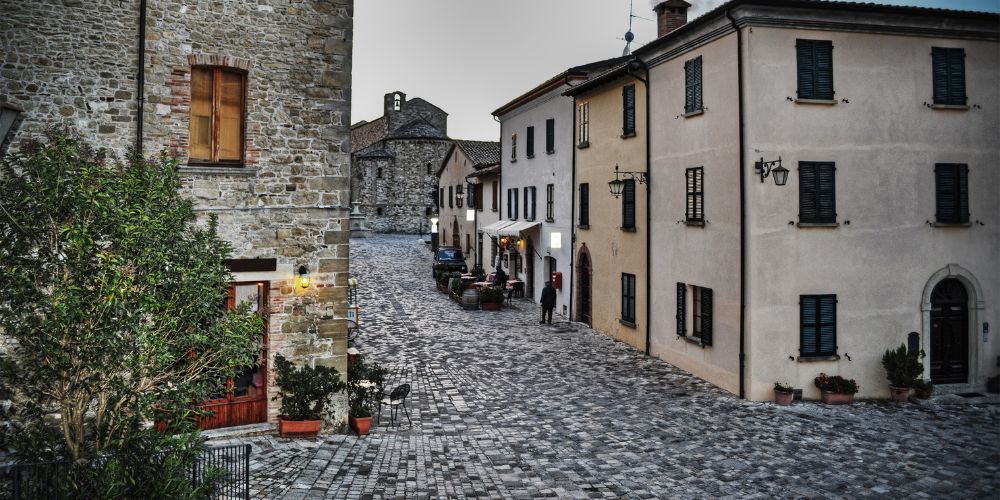
The history of San Leo is very ancient, indeed the first signs of settlements in the area date back to Roman times; but it is only from the Middle Ages that its relevance and fame began to grow, remaining untouched nowadays. For centuries, the village has been the cultural and administrative core of the historic Montefeltro region, a territory that included the current provinces of Rimini, Arezzo, Pesaro-Urbino and the Republic of San Marino, so much that it was considered the actual capital.
Perhaps due to its strategic geographical position right in the heart of this ancient Italian region, or more simply due to its natural panoramic magnificence which has always inspired charm and power at first sight, San Leo has been a real crossroads which has attracted some of the greatest names in history, among which those of the Medici family, St. Francis of Assisi and Dante Alighieri stand out - not surprisingly, the town is mentioned in the Divine Comedy as a metaphor for the strenuous climbing up to the top of the Purgatory mountain.
Today, the traces of its important past are still clear and evident and you can discover them by breathing in history and stories that come to life every day in the splendor of the narrow streets and buildings of this gem in the hinterland of Romagna: follow us on this journey which, just like Dante, will take us beyond the boundaries of history in this fantastic setting.
The fortress of San Leo
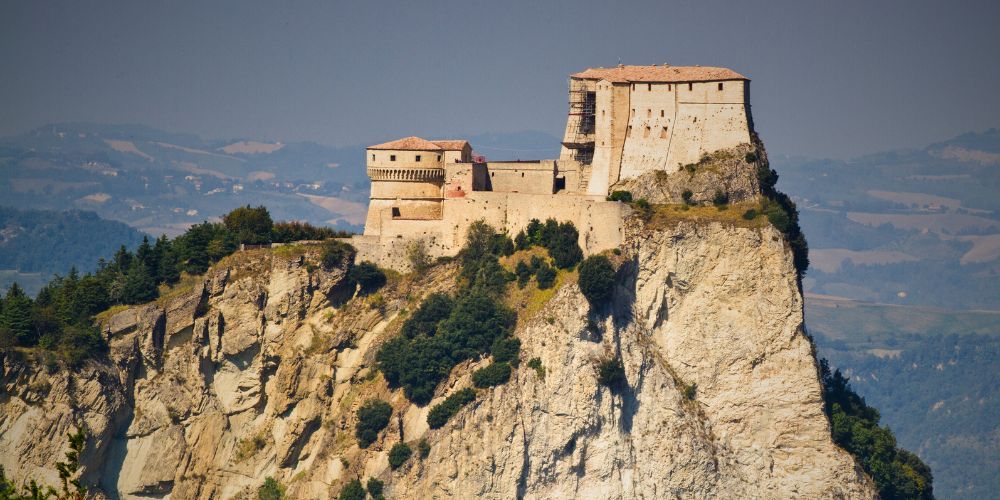
The fortress of San Leo is undoubtedly the most iconic and dominant symbol of the village and of the entire Valmarecchia, witnessing the concrete sense of power, austerity and authority that affected this territory for centuries, fascinating the desire for supremacy of the protagonists of medieval and renaissance Italy, including kings, noble families and even the papacy.
With the definitive annexation of the castle to the Papal State in 1631, and with its transformation from a military outpost to an impregnable prison, the history of the fort of San Leo was enriched by new and fascinating pages: we also like to think that it has changed even the color of the ink used to write it, putting aside the red of the blood of the many battles fought within its walls to switch to the intensity of blue or black, colors that well match with the eventful life of its most famous prisoner.
We are talking about Giuseppe Balsamo known as Cagliostro, an eccentric character of the eighteenth century known above all for his relationships with Masonry and his fraudulent visits to the most important and influential European courts of the time, such as the Russian and French ones - in particular, he was one of the protagonists involved, unfortunately for him, in the famous Marie Antoinette’s necklace affair. Also well known for his scams of all sorts and for his alleged skills as a healer and alchemist, he was convicted of heresy and imprisoned in the fort of San Leo, inside a special cell without doors, where he spent his last years until death.
Discover RiminiAnother very particular oddity regarding the fort of San Leo concerns the legendary figure of the 'magician of the fortress'. In fact, according to an ancient legend whose origins are lost in the ancient history of the town, in a distant era the castle was the home of a mysterious and nameless magician, gifted with exceptional powers such as the manipulation of space and time. His spirit still seems to dwell the walls of this bastion with its unique panoramic charm; but legend or not, today many people associate this story simply with the image of Cagliostro and his period of imprisonment inside the fortress, which in fact also became his tomb.
Today, fortunately, the walls of the San Leo fort are no longer the scenery of battles and prisons and it is possible to visit museums, exhibitions and artistic collections on the inside, above all one dedicated to weapons and war finds from the sixteenth century up to the second world war.
The cathedral of San Leo
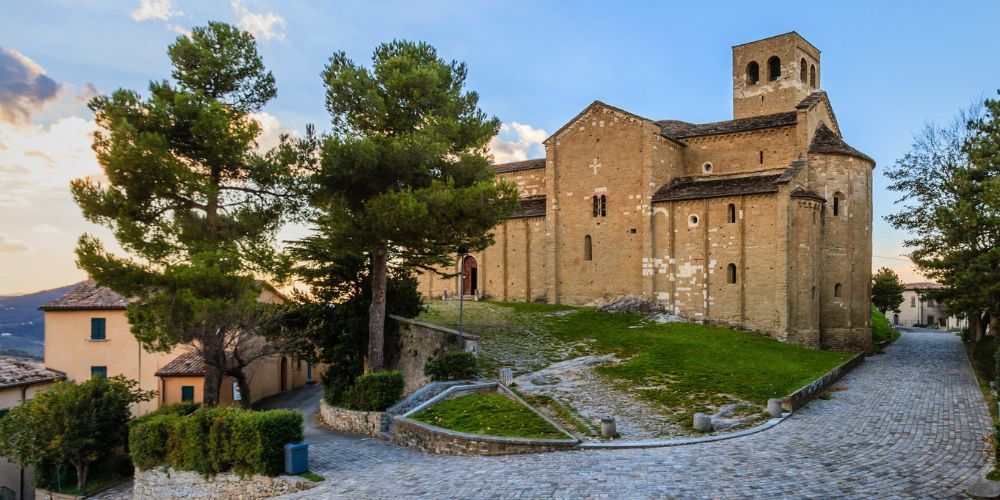
Let’s continue our tour descending towards the village and exploring its historical magic at the sight of the cathedral of San Leo, the most solemn religious building of the place which stands on a rock spur which was already used as a sacred place in prehistoric times for the worship of long forgotten gods. The cathedral, as we know it nowadays, was built in the heart of the Middle Ages (an incision on a pillar inside the church reports the date 1173) on the foundations of the first ancient cathedral dating back to the seventh century, when San Leo was designated as the seat of a diocese.
More than a thousand years have passed since then and that diocese today still stands within the walls of the cathedral of San Leo; or rather, only symbolically half. In fact, it’s definitely one of a kind situation, but San Leo shares with Pennabilli the title of cathedral of the diocese of San Marino-Montefeltro in what was defined as a single cathedral in the space of two churches, both dedicated to San Leone, as well as in the space of two states, Italy and the Republic of San Marino. Inside the church, designed in Romanesque style, it is possible to admire some relics of the saint.
The parish of the Assumption of Mary
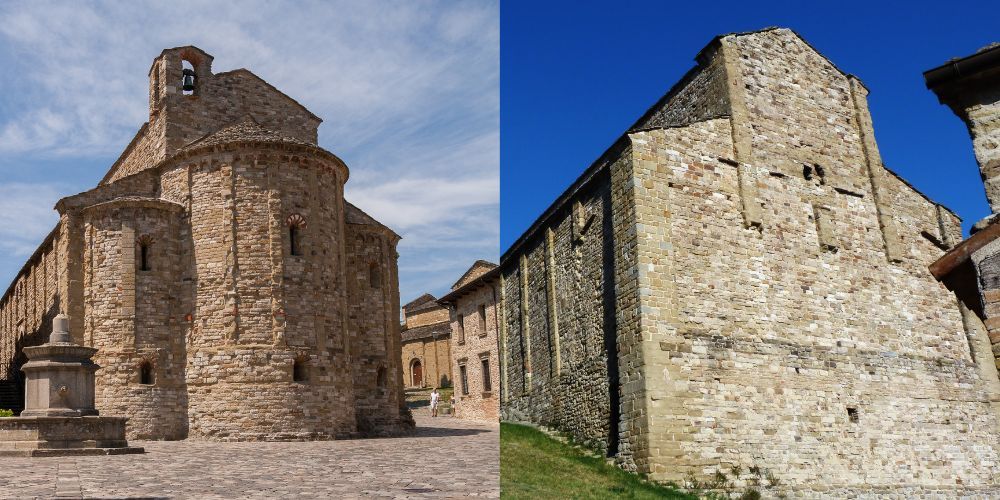
The parish of the Assumption of Mary, unlike the cathedral, is instead the oldest religious place in San Leo with a historical dating of the current building estimated to be around the ninth century, nevertheless preserving the remains of an older church within its foundations and crypt.
In fact, according to traditions, it was San Leo himself who started the construction of the first place for the Christian worship in this territory, between the third and fourth centuries: a fascinating theory validated by historical sources which attribute to the saint, during his earthly life, the profession of the stonemason. One sure thing is that nowadays the parish of the Assumption of Mary is definitely one of the attractions to visit in this village in Romagna.
The bell tower

The bell tower of San Leo is undoubtedly one of the most recognizable icons of the village, given its imposing (and even threatening) size which makes it visible even from a long distance. This innate ability to stand out from other buildings is a quality that also reflects its very nature. In fact, if on one side its aesthetics is perfectly alike to the cathedral, on the other hand its solitary and arduous position compared to the other places of interest in the town has always made the understanding of its function unclear.
What is striking, however, is its architectural shape which seems to express itself as a mystical metaphor of the relationship between earthly physicality and spirituality: in fact, the building arises starting from the rock, remaining one thing with it, and then rises for its whole height towards the sky with a privileged panoramic view over the surrounding landscape. Fascinating, isn’t it?
The Medici’s palace
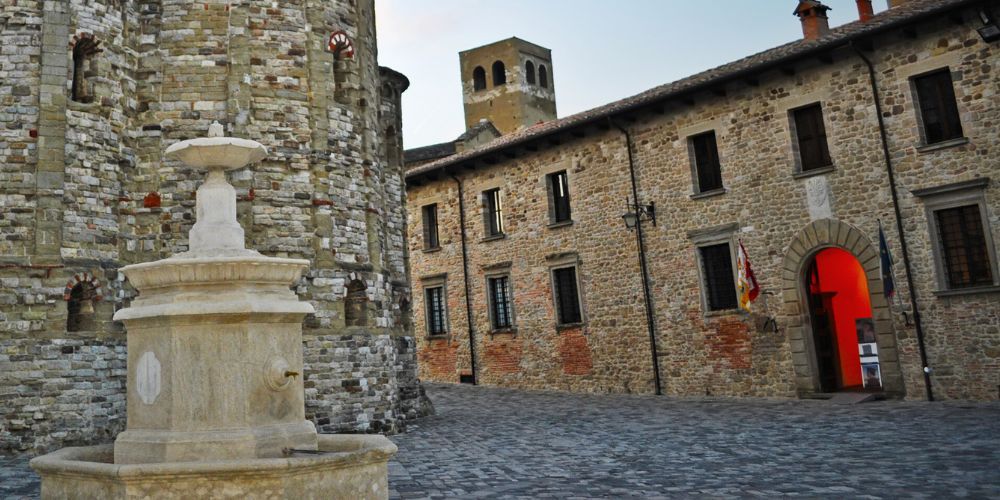
The Medici’s palace in San Leo is a real monument that celebrates the military victory achieved by Florence over Montefeltro in 1517, the same year in which the construction of this majestic renaissance building began (completed in 1523) as a residence for the local governor on behalf of the Medici. The building is located in Piazza Dante, in the area between the cathedral and the parish church, and since 1996 it has housed an interesting museum of sacred arts which collects paintings, sculptures and sacred decors and intends to tell the story of the territory through the passion of faith.
How to get to San Leo
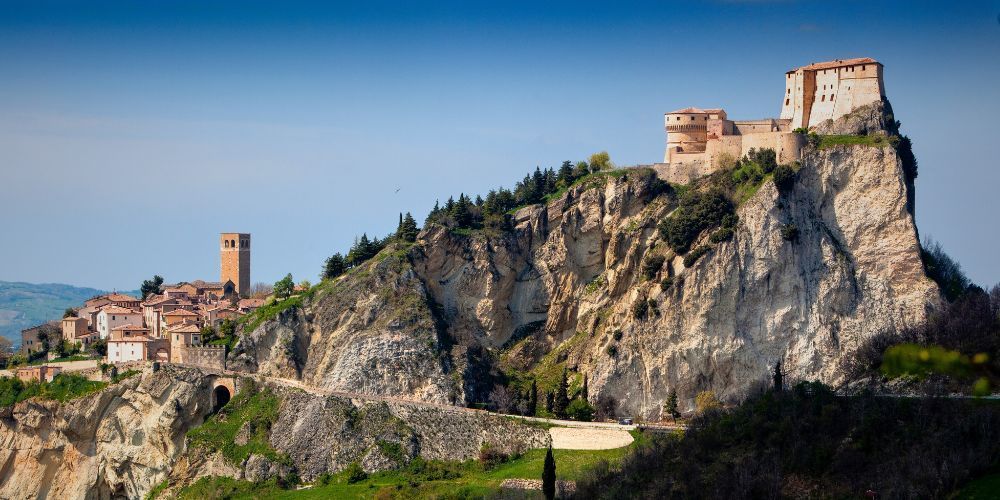
Starting from Rimini, the capital of the province, there are two ways to easily get to San Leo or vice versa: traveling by car or traveling by bus, two routes covering a distance of about 30km.
The itinerary by car takes about 45 minutes. It starts from the city along the SP258, the so-called via Marecchiese, proceeding for a long way up to Pietracuta; once in Villanova, take the SP22 and then via Montefeltro driving through Valmarecchia and going up the hills until you reach the town of San Leo. Don't worry, the majestic fortress will be ready to welcome you to the city by peeping out of the clouds from the top of its rocky throne overlooking the valley!
The itinerary by bus, on the other hand, lasts about an hour and follows an identical route to the car’s one, just with a bus line change halfway. It starts from the central station of Rimini by taking line 160, which runs along the SP258 up to Pietracuta, where you change the bus to take line 102 which runs along the SP22 and via Montefeltro up to San Leo. For further information click here!
What to do after visiting San Leo: explore the attractions of Rimini and Romagna
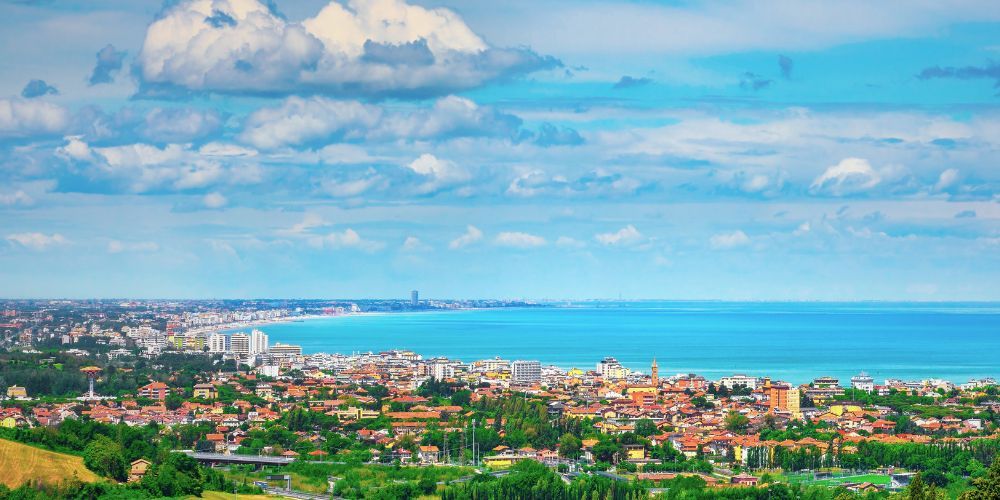
At the end of our journey to San Leo, the adventures in Romagna are not over yet! It is now the perfect time to move from the hinterland to the coast and discover the best attractions of Rimini and other beautiful places of Riviera!
Together with us you will be able to explore the city in the most authentic way, immersing yourself in the magical atmosphere of Italian cinema by visiting the Fellini Museum or picturing yourself like Gulliver in the land of Lilliput at the extraordinary miniature park Italia in Miniatura. And don't forget to have lunch with the delicious piadina romagnola, a symbol of traditional Italian cuisine!
We also recommend you to proceed South along the coast and visit two other splendid towns: Riccione, where with us you can discover the wonders of the Oltremare park, or Cattolica, a city on the border with the Marche region that hosts the largest aquarium on the Italian Adriatic coast. To learn more about curiosities and useful tips for planning your trip to Romagna with family, take a look here!
About the author
Written on 08/09/2023


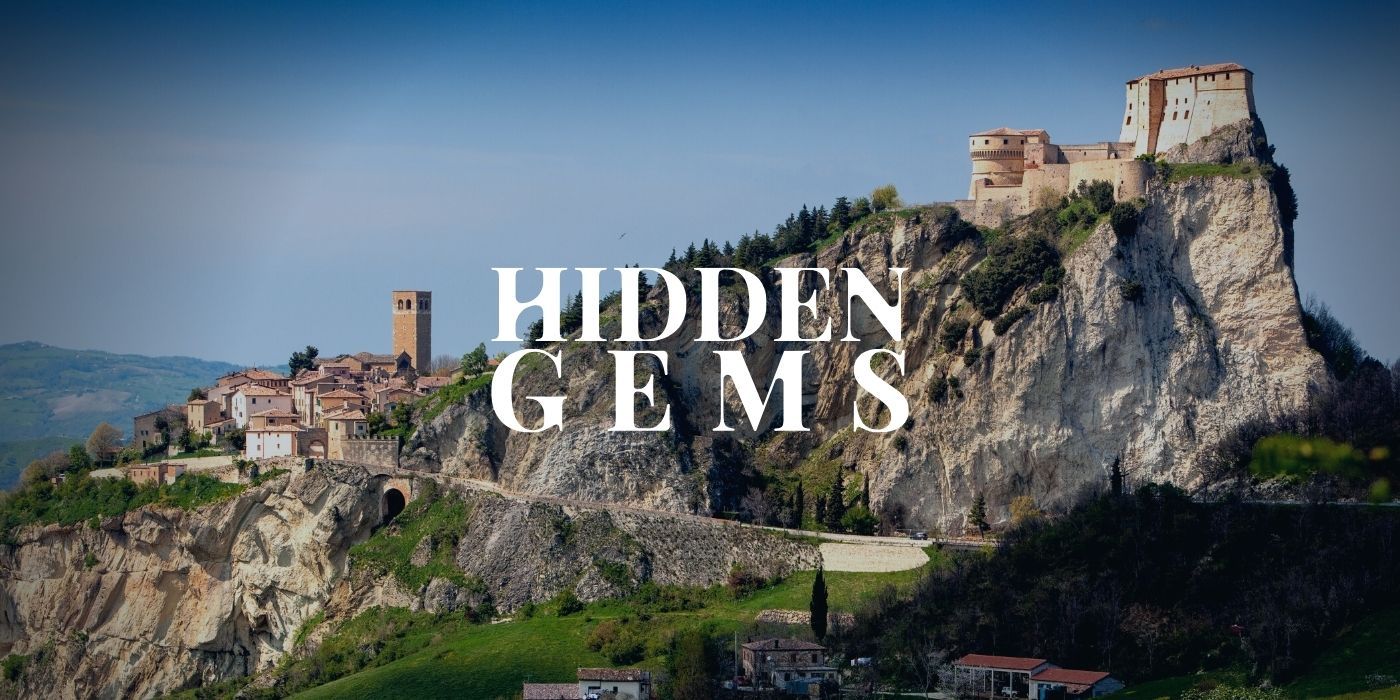
Massimiliano Antonio Primi
A stunning fortress on top of a rocky spur and a village where you can breathe history: that’s San Leo, the unexpected side of Romagna you don’t know.